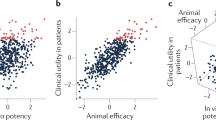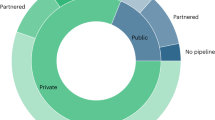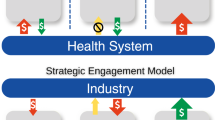Key Points
-
The development of a new drug requires a major investment of capital, human resources and technological expertise. It also requires strict compliance with regulations on testing and manufacturing standards before a new compound can be used in the general population.
-
All these requirements contribute to the cost increases for new chemical entity (NCE) R&D. The central question raised by this trend is: who in the future will pay for new pharmaceutical R&D?
-
With this question in mind, this article first describes how the environment for pharmaceutical R&D has changed over time, and the effect of these changes on R&D cost, risk and the time invested; second, reviews the literature on the cost of drug discovery and development for NCEs; and third, considers the societal value of new drugs.
Abstract
The public desire for new therapies, their increasing cost and the increased role of government as a payer for innovative new drugs all converge on the issue of the rapidly rising cost of new drug development — now thought to be greater than US $800 million — and highlight the necessity for an efficient use of resources. With this in mind, here we review studies on the cost of developing new drugs and consider how this cost has, and could be, affected by the changing environment for pharmaceutical research and development.
This is a preview of subscription content, access via your institution
Access options
Subscribe to this journal
Receive 12 print issues and online access
$209.00 per year
only $17.42 per issue
Buy this article
- Purchase on Springer Link
- Instant access to full article PDF
Prices may be subject to local taxes which are calculated during checkout




Similar content being viewed by others
References
Neumann, P. J. Evidence-based and value-based formulary guidelines. Health Affairs 23, 124–134 (2004).
American Heart Association. Heart Disease and Stroke Statistics – 2004 Update. American Heart Association [online],(2004).
P. L. 102-571, Title I, Section 103. The Prescription Drug User Fee Act of 1992.
Kaitin, K. Tufts Center for the Study of Drug Development News Release. [online], <www.csdd.tufts.edu> (2003).
Government Accounting Office. Effect of User Fees on Drug Approval Times, Withdrawal, and other Agency Activities. GAO report 02-958, Washington, September 2002 [online], <http://www.gao.gov/new.items/d02958.pdf> (2002).
Kaufman, M. Decline in new drugs raises concerns. Washington Post November 17 (2002).
DiMasi, J. A. Risks in new drug development: approval success rates for investigational drugs. Clin. Pharmacol. Ther. 69, 297–307 (2001).
Grabowski, H. The effect of pharmacoeconomics on company research and development decisions. PharmacoEconomics 11, 389–397 (1997).
DiMasi, J. A., & Hansen, R. W. & Grabowski, H. G. The price of innovation: new estimates of drug development costs. J. Health Econ. 22, 151–185 (2003). This study, which updates earlier work on the average cost of NCE development, estimated the cost of drug development for self-originated NCEs to be US $802 million in 2000 dollars.
Wardell, W. M., & Hassar, M., Anavekar, S. N. & Lasagna, L. The rate of development of new drugs in the United States, 1963 through 1975. Clin. Pharmacol. Ther. 24, 133–145 (1978).
Wardell, W. M., DiRaddo, J. & Trimble, G. Development of new drugs originated and acquired by United States-owned pharmaceutical firms, 1963–1976. Clin. Pharmacol. Ther. 28, 270–277 (1980).
Wardell, W. M., May, M. S. & Trimble, G. New drug development by United States pharmaceutical firms. Clin. Pharmacol. Ther. 32, 407–417 (1982).
Mattison, N., Trimble, G. & Lasagna, L. New drug development in the United States, 1963 through 1984. Clin. Pharmacol. Ther. 43, 290–301 (1988).
DiMasi, J. A., Bryant, N. R. & Lasagna, L. New drug development in the United States from 1963 to 1990. Clin. Pharmacol. Ther. 50, 471–486 (1991).
DiMasi, J. A. Success rates for new drugs entering clinical testing in the United States. Clin. Pharmacol. Ther. 58, 1–14 (1995).
DiMasi, J. A. New drug development in the United States from 1963 to 1999. Clin. Pharmacol. Ther. 69, 286–296 (2001).
Grabowski, H. & Vernon, J. The distribution of sales revenues from pharmaceutical innovation. PharmacoEconomics 18, S1, 21–32 (2000).
Grabowski, H. & Vernon, J. A new look at the returns and risks to pharmaceutical R&D. Management Sci. 36, 804–821 (1990).
Joglekar, P. & Paterson, M. A closer look at the returns and risks of pharmaceutical R&D. J. Health Econ. 5, 153–177 (1986).
Grabowski, H., Vernon, J. & DiMasi, J. Returns on research and development for 1990s new drug introductions. PharmacoEconomics 20, S3 11–29 (2002).
Grabowski, H. & Vernon, J. Effective patent life in pharmaceuticals. Intl J. Tech. Management 19, 98–120 (2000).
Grabowski, H. Patents, innovation and access to new pharmaceuticals. J. Intl Econ. Law 5, 849–860 (2002).
Grabowski, H. & Vernon, J. Longer patents for increased generic competition in the US: The Waxman–Hatch Act after one decade. PharmacoEconomics 10, S2 110–123 (1996).
Centers for Medicare and Medicaid Services. Hospital Outpatient Prospective Payment System Related Information. [online], <http://cms.hhs.gov/providers/hopps> (2004). This is based on Section 4523 of the Balanced Budget Act of 1997 for which the final rule was published in the Federal Register on 7 April 2000. The new rule became effective on 1 August 2000. Specific payment rates are published each year and are available at the address above.
P. L. 108-173, Medicare Prescription Drug Improvement and Modernization Act.
Centers for Medicare and Medicaid Services. [online], <http://www.cms.gov> (2004).
US Census Bureau [online], <http://www.census.gov> (2004).
Department of Veterans Affairs [online], <http://www.va.gov> (2004). Medicaid enrollment in 2001 was 36.6 million (from reference 26), and in 2000 the Department of Defense population was 1.4 million (from reference 27) and the Veterans Administration (VA) enrollment was 26.5 million; however, the VA health system served only 4.2 million of this population (from reference 28). In 2000, Medicare had 39.1 million eligibles (from reference 26). If the total federally covered population is calculated using total VA population, this gives 103.6 million or 36.4% of the 2001 US population of 284.8 million. However, if the total is calculated using the number of VA eligibles treated, the comparable proportion is 28.5%.
National Conference of State Legislatures. 2001 Prescription Drug Discount, Bulk Purchasing, and Price-Related Legislation. Data for this report was last updated in February 2003. <http://www.ncsl.org/programs/health/drugdisc01.htm> (2003).
Watson Wyatt . Retiree Health Benefits: Time to Resuscitate? [online], <http://www.watsonwyatt.com/research/resrender.asp?id=W-559&page=1> (2004).
US Census Bureau [online], <http://www.census.gov/population/www/socdemo/age.html#bb> (2003).
US Census Bureau, Census 2000 Summary File 1: 1990 Census of Population, General Population Characteristics, United States (1990 CP-1-1).
US Census Bureau [online], <http://www.census.gov/population/www/projections/nation/summary/np-t3-e.txt> (2003). See tables NP-T3-B through to NP-T3-E.
[online], <http://www.theorator/bills108/hr2427.html> (2003).
Hansen, R. W. in Issues in Pharmaceutical Economics (ed. Chien, R. I.) 151–187 (Lexington Books, Lexington, 1979)
Wiggins, S. N. The Cost of Developing a New Drug (Pharmaceutical Manufacturers Association, Washington, 1987).
Woltman, H. R. Reviewing the bidding: R&D costs and profitability of new chemical entities. J. Res. Pharm. Econ. 1, 49–65 (1989).
DiMasi, J. A., Hansen, R. W., Grabowski, H. G. & Lasagna, L. Cost of innovation in the pharmaceutical industry. J. Health Econ. 10, 107–142 (1991).
US Department of Commerce, Bureau of Economic Analysis. Seasonally adjusted gross domestic product implicit price deflator 2002. [online], <http://www.bea.gov> (2002).
US Congress, Office of Technology Assessment. Pharmaceutical R&D: Costs, Risks, and Rewards OTA-H-522 (US Government Printing Office, Washington, 1993).
Public Citizen Congress Watch 2001. Rx R&D Myths: The Case Against the Drug Industry's R&D 'Scare Card' (Public Citizen, Washington, 2001).
Public Citizen. Tufts drug study sample is skewed; true figure of R&D costs is likely 7 percent lower. [online], <http://www.citizen.org/pressroom/release.cfm?ID=954> (2002).
National Institutes of Health. NIH Contributions to Pharmaceutical Development Administrative Document. (NIH, February 2000).
Big pharma likes big trials, Biotech CEO says; Tufts defends R&D estimate. The Pink Sheet June 10, p 17 (2002).
Ernst & Young . Pharmaceutical Industry R&D Costs: Key Findings about the Public Citizen Report, August 8, 2001. [online], <http://www.phrma.org/mediaroom/press/releases/2001-08-11.277.pdf> (2002).
PhRMA. The Pharmaceutical Industry's R&D Investment, February 1, 2000 [online], <http://www.phrma.org/publications> (2002).
Tufts Center for the Study of Drug Development. Total cost to develop a new prescription drug, including cost of post-approval research, is $897 million. [online], <http://www.csdd.tufts.edu/newsevents/recentnews> (2003).
Tollman, P. et al. A Revolution in R&D. (Boston Consulting Group, Boston, 2001). [online], <http://www.bcg.com> (2002).
DiMasi, J. A. The value of improving the productivity of the drug development process. PharmacoEconomics 20, S3 1–10 (2002).
Foote, S. M. & Etheredge, L. Increasing use of new prescription drugs: a case study. Health Affairs 19, 165–170 (2000).
Fuchs, V. R. Health care for the elderly: How much? Who will pay for it? Health Affairs 18, 11–21 (1999).
Weisbrod, B. A. & LaMay, C. L. Mixed signals: public policy and the future of health care R&D. Health Affairs 18, 112–125 (1999).
Kleinke, J. D. The price of progress: prescription drugs in the health care market. Health Affairs 20, 43–60 (2001).
Lichtenberg, F. R. Are the benefits of newer drugs worth their cost? Evidence from the 1996 MEPS. Health Affairs 20, 241–251 (2001).
Lichtenberg, F. R. Benefits and costs of newer drugs: An update. NBER Working Paper 8996. Cambridge, MA: NBER, June 2002. [online], <http://www.nber.org/papers/w8996> (2002).
Redwood, H. Where is the Pharma Industry Going: Insights for the New Millennium. (PJB Publications, London, 2002).
Price Waterhouse Coopers. The Critical Roles of R&D in the Development of New Drugs (PWC, Washington, 2001).
National Institutes of Health. NIH Budget, Office of Budget, History of Congressional Appropriations, 1992–2001. Available on-line at www.nih.gov. (8/14/02)
US FDA. From Test–tube to Patient: Improving Health Through Human Drugs. (FDA Washington, 1999). [online], <http://www.fda.gov> (2002).
Glover, G. J. Testimony for the Pharmaceutical Research and Manufacturers of America before the Federal Trade Commission and the Department of Justice – Antitrust Division. Washington, March 19, 2002 [online], <http://www.phrma.org/publications/documents/backgrounders//2002-06-24.431.phtml> (2002).
Testing drugs in people. [online], <http://www.fda.gov/fdac/special/newdrug/testing.html> (1995).
DiMasi, J. Trends in drug development costs, times and risks. Drug Information Assoc. J. 29, 375–384 (1995).
Acknowledgements
We thank two anonymous reviewers for their helpful comments; all errors and omissions remain the responsibility of the authors.
Author information
Authors and Affiliations
Corresponding author
Ethics declarations
Competing interests
J.P.G. is an employee of Aventis Pharmaceuticals Inc.
Related links
Glossary
- ACADEMY OF MANAGED CARE PHARMACY FORMULARY GUIDELINES
-
The Academy of Managed Care Pharmacy's Format for Formulary Submissions, published in October 2000, is a set of guidelines for the evaluation of medications. The Format is helping to answer the often-asked question: “which new drugs offer advantages at reasonable costs, thus providing good value?” There are two important goals for the Format process: first, to improve the quality, timeliness, scope and relevance of the data and information made available for pharmacy and therapeutics committees to use in their decision-making; and second, to facilitate and streamline the acquisition of data and information and the review process for pharmacists in managed-care organizations.
- SAFETY
-
Safety is determined by balancing risk and benefit for a given disease.
- EFFICACY
-
The ability of a drug to work under ideal conditions (for example, in a well-controlled clinical trial).
- REVIEW TIME
-
The FDA defines review time as the time it takes the FDA to review a New Drug Application.
- APPROVAL TIME
-
The FDA defines approval time as the time from the first New Drug Application (NDA) submission to NDA approval. It includes the sum of FDA review time for the first submission of an NDA to the Agency, plus any subsequent time during which a pharmaceutical sponsor addresses deficiencies in the NDA and resubmits the application, plus subsequent FDA review time.
- EFFECTIVE PATENT LIFE
-
EPL is defined as the number of years of market exclusivity for a product once it has received marketing approval. EPL will always be less than the nominal patent life because drug entities are patented long before they receive marketing approval.
- MEDICARE
-
The federal health insurance programme for people 65 years of age or older, certain younger people with disabilities and people with end-stage renal disease.
- MEDICAID
-
A joint federal and state programme that helps with medical costs for some people with low incomes and limited resources. Medicaid programmes vary from state to state, but most healthcare costs are covered if you qualify for Medicare and Medicaid.
- STUDY PARAMETER CHANGES
-
The methodological differences between the 1991 and the 2003 DiMasi studies can be briefly summarized as: first, the 1991 study examined 93 self-originated NCEs from 12 companies, whereas the 2003 study was based on 68 self-originated NCEs from 10 companies; second, the cost of capital was 9% in the 1991 study and 11% in the 2003 study; third, the average time from beginning clinical trials to marketing approval in the 1991 study was 98.9 months, but 90.3 months in the 2003 study; and last, the average clinical success rate for the 1991 study was 23%, compared with 21.5% in the 2003 study.
- CAPITALIZATION
-
The amounts and types of long-term financing used by a firm to grow and expand its business. It may include common stock, preferred stock, retained earnings and long-term debt. Capitalized costs are out-of-pocket costs that have been discounted at an appropriate discount rate to address the time value of money.
Rights and permissions
About this article
Cite this article
Dickson, M., Gagnon, J. Key factors in the rising cost of new drug discovery and development. Nat Rev Drug Discov 3, 417–429 (2004). https://doi.org/10.1038/nrd1382
Issue Date:
DOI: https://doi.org/10.1038/nrd1382
This article is cited by
-
Bioengineered amyloid peptide for rapid screening of inhibitors against main protease of SARS-CoV-2
Nature Communications (2024)
-
A knowledge-guided pre-training framework for improving molecular representation learning
Nature Communications (2023)
-
Multitask joint strategies of self-supervised representation learning on biomedical networks for drug discovery
Nature Machine Intelligence (2023)
-
Antimicrobial efficacy of Mentha piperata-derived biogenic zinc oxide nanoparticles against UTI-resistant pathogens
Scientific Reports (2023)
-
CSDTI: an interpretable cross-attention network with GNN-based drug molecule aggregation for drug-target interaction prediction
Applied Intelligence (2023)



